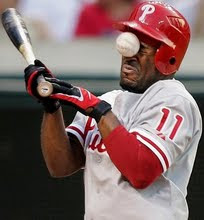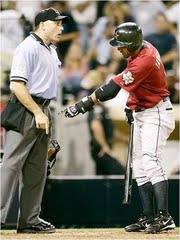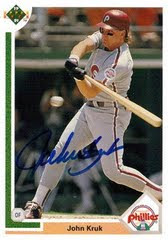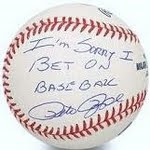So my strategy for drafting starting pitchers was firmly placed on the following dynamics:
1) FIP and xFIP
2) D/E and Aggregate Fielding Runs
3) LOB%
4) K/9
5) PAP and the Verducci Effect
I focused on FIP for obvious reasons. I wanted to know whose success was "for real" (ie, Dan Haren) and whose success was the byproduct of luck (ie, Gavin Floyd). As I often advocate everyone do, I checked ERA/FIP splits and tried to avoid guys whose ERAs didn't quite match up with their FIPs. I strongly believe that guys who outperform their FIPs - like Johan Santana - even if they are great, will be incredibly overvalued. Furthermore, I checked FIP to find guys who UNDERPERFORMED their abilities last year. I hunted down guys like Jonathan Sanchez and Javier Vazquez, who posted quality FIPS below 4, but ERAs upwards of 4.5. Guys like Vazquez, who get an "unclutch" label, are perfectly undervalued targets.
Following FIP, I looked at the Defensive Efficiency (a metric that analyzes how efficient teams are at converting balls put into play into outs) and a team's cumulative fielding runs above/below average (broken down by infield, outfield and whole team). The goal here was to find out which teams are very good, average and below average at fielding. By determining this, I could figure out which pitchers could reasonably outperform/underperform their FIPs for 2009. I can confidently state that a guy like James Shields -- a groundball pitcher backed by the game's best defensive infields -- is going to continue to outperform his already quality FIP going forward. At the same time, I question whether or not the Rockie's defense (amongst other factors) provides enough coverage to match Ubaldo Jimenez's quality peripherals to his ERA.
I then looked at player's Left On Base Percentages (LOB%) to see whether or not which pitcher's ERAs were strongly biased due to positive/negative luck. Since non-HR hits are incredibly situational, you have to expect a lot of regression towards the mean in a player's LOB% from year to year. Guys with large FIP/ERA splits like Jonathan Sanchez -- who is on a defensively challenged team, but also posted an unlucky 67.5 LOB% (league average is 72.5%) -- scream value to me. At the same time, Johan Santana's declining peripherals and league leading 82.6 LOB% tells me that not only would I be overpaying for Santana, but that his "return to form" year may have not actually been a return to form.
After FIP, Fielding Runs and LOB%, I looked at guys based on K/9 rates. I figure that if I am going to excel in any category, I want it to be the one pitchers have the most control over. Teams can unexpectedly suck (low Wins total), while Save Opps, WHIP (which is comprised of HITS) and ERA are all situational. Pitchers have absolute control over only exactly three things: strikeouts, walks and home runs. Thus, choosing high K guys is the most logical thing to do. Plus, guys with higher K rates tend to perform closer to their FIPs due to their "ability to get out of jams" without relying on the defense behind them. In terms of pitching K/9 is pretty consistent, which is important to a drafting strategy of value retention (minimizing risk).
Finally, I checked out how abused pitchers were last year to decide whether or not I wanted to take on the risk of injury by drafting them. Young pitchers (under 26) who had huge inning leaps (Cole Hamels increased his workload by 44 innings last year) or heavy workloads (Tim Lincecum lead the league in PAP points) scare me -- especially if they go in the top 6 rounds. As I pointed out in my analysis of John Danks,
Baseball Prospectus has shown, pitchers are most brittle before the age of 24 and after the age of 35. Tom Verducci observed that pitchers under the age of 25 who increase their seasonal workload by more than 25-30 innings in a single season are the most susceptible to injury the following year.I adhere strongly to that data.
As should be evident by my picks of Dan Haren (Dr. Consistent), Javier Vazquez, Josh Beckett, Yovani Gallardo, Erik Bedard, Jonathan Sanchez, Manny Parra and Brandon Morrow should indicate, I stuck pretty closely to my value retention strategy. The only high risk, late round guy I pulled was Morrow -- largely because he's got so much upside and will either be a quality starter or the team's closers.
As you should also already know by now, I hate closers, so it shouldn't surprise you that I picked up Jason Motte, Leo Nunez and Chad Qualls to supplement Jose Valverde -- who is one of the best RPs in baseball and one of the very few closers (the others being Joe Nathan, Kerry Wood, Jonathan Broxton and maybe Heath Bell) I would ever consider drafting "early."
Go know and use my knowledge, dear child.







2 comments:
1) I'm going to beat you, no matter what
2) It's a great strategy don't get me wrong, but the problem with that is that it's EXTREMELY TIME CONSUMING. Not many people have the time like you do to out together and research all those factors
Pitching Staff and breakdown:
Dan Haren -- Dan Haren is Dr. Consistent. In each of the past 3 seasons, Dan Haren has decreased his FIP, posted 215+ IP, increased his K/9 rate and decreased his home run propensity. Last year, Haren's FIP was 3.01, meaning he slightly "under peformed" his FIP -- probably due to the Below Average team defense (although that didn't seem to hurt Brandon Webb much -- who I avoided due to a combination of his groundball tendencies and a declining infield defense). There is no reason that Haren won't continue to dominate in every category except Wins next year.
Josh Beckett -- After two consecutive season of 200+ IP, the injury bug again bit Beckett, limiting him to a serviceable 27 starts, 175 IP. His ERA was 4.03, but the FIP was a sparkling 3.24. Beckett's K rate has been increasing since 2006, while his BB rate has declined over that same period. Boston had a top 5 defensive team last year and Beckett had an average 71.3 LOB%. All signs point to Beckett to return to great success next year.
Javier Vasquez is one of my two most valued pitchers for 2009. A combination of his lack of success in the AL (minus 2007) in recent years matched against his great peripherals make him unfairly undervalued. Despite posting a FIP of 3.86 or lower each of the past 3 seasons, the absolutely TERRIBLE defense of the Chicago White Sox resulted in ERAs of 4.84, 3.73 and 4.67. Last year, Vasquez struck out 8.64 guys per nine, walked 2.64 per nine and gave up a little over a home run per game (1.08 HR/9). Vasquez's 68.3 LOB% also contributed heavily to the inflated ERA. In short, Vasquez's move away from the HR friendly Cell, defensive challenged White Sox and stronger hitting AL to the defensively strong Braves and pitcher-who-bats NL should only make him a top 10 guy in 2009.
Yovani Gallardo -- Let me say this one more time. Gallardo is not a health risk. He is not Ben Sheets. His injuries have never been the result of pitching mechanics, abuse, etc., but a slew of freak accidents on the field that have delayed his inevitable dominance to 2009. Even if he only pitches 170 innings this year (27 starts), Gallardo will provide the Brewers with some of the best innings in baseball. in 134 big league innings, Gallardo has a 3.53 FIP and 8.11 K/9. Expect big things this year.
Erik Bedard -- There is some health risk here, but the career 8.66 K/9 upside is too much to overlook with a 174 ADP. Injury concerns limited Bedard's talent last year, as a four-year high 4.11 BB/9 rate inflated his FIP from a career rate below 3.67 to 4.32. Bedard is supposedly healthy now and a strong start will give me strong trade bait from a late round pick to acquire brian roberts from a guy who needs pitching.
Jonathan Sanchez -- Another guy who gets a bad rep due to high ERA/FIP splits and bad luck. Jonathan Sanchez may have a below average defense behind him this year, but his 3.85/5.01 FIP/ERA split in 2008 calls for some extreme regression. In 250 big league innings, Sanchez has struck out 252 guys. Fangraph notes that "batters swung and missed at 10.9% of his Sanchez’s pitches, the 9th highest total in baseball." This, combined with a 67.5 LOB% in 2008 tell me that Sanchez is bound to improve. He, with Javier Vasquez, were my two big sleeper picks.
Brandon Morrow -- He's either going to start or close for Seattle, so there is less risk associated with this late round pitcher than most. After striking out 141 guys in 128 innings, Morrow began the transition from RP to SP late last season. Despite shaky control (4.73 BB/9, down from 7.11 BB/9 in 2007), spacious SafeCo -- mixed with his sick fastball that is strongly supplemented by a plus slider and quality split finger pitch -- put all the chips in place for a 2009 breakout campaign. Did I mention the big league 9.9 K/9 rate?
Finally, we come to my final SP: Manny Parra. Manny Parra is not a guy I entirely trust, but believe has a lot of potential. With big expectations, I took Parra last season (before his mid-late season success) and learned just how bad Parra's high BB rate (4.07 per nine) could burn. Between April and May, Parra put up 55 innings of 4.74 ERA, 1.5 WHIP baseball and would have killed my ratios if not for guys like Scott Baker, Dan Haren and Cole Hamels. Parra's promising minor league track (FIP below 3, 9 K/9 rate) mixed with his extreme groundball tendencies tell me that Parra could experience great success with a quality defense behind him to limit the walk rate damage. Unfortunately, Milwalkee's infield features Prince Fielder (-1.0 fielding wins last year) and Rickie Weeks (-.5 fielding wins last year) on the right side of the infield. Overall, Milwalkee's defense is slightly below average, so Parra's road to success will be an uphill climb, but if he cal lower the BB/9 rate, I expect big things this year and next.
Post a Comment